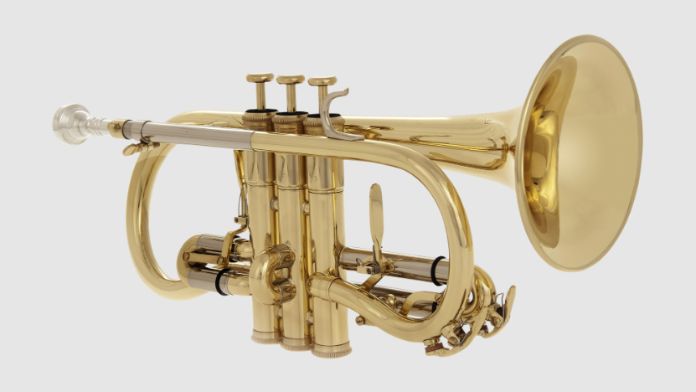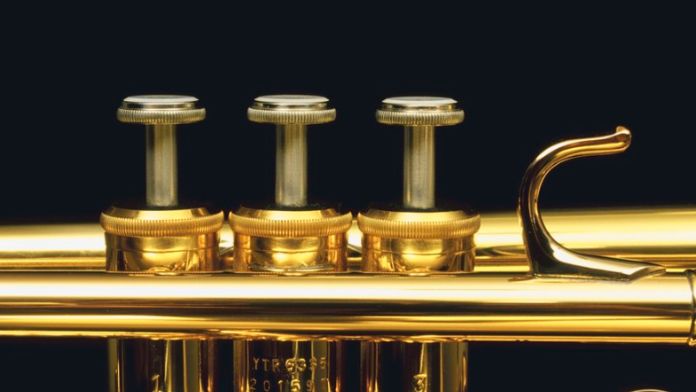The 9 Types of Trumpets Every Brass Player Should Know
Trumpets. They’re loud, they’re commanding, and they’re used in a variety of different applications. There’s a trumpet in there, whether it’s a film score, military use, or jazz band. But this isn’t a one-size-fits-all type of situation; there are nine common types of trumpets, each with a slightly different tone, construction, and purpose.
So, if you want to learn the trumpet yourself or are just an intrigued brass player, read on as we discover these nine types!
IN A HURRY?
Here are the nine types of trumpets we’ll discuss in this article and a recommendation for each!
| Type of Trumpet | Instrument Recommendation |
| Bb trumpet | Student Trumpet by Gear4music |
| Cornet | Student Cornet by Gear4music |
| C trumpet | Coppergate C Trumpet by Gear4music |
| Bb pocket trumpet | Pocket Trumpet by Gear4music |
| Flugel horn | Levante by Stagg FH6205 Flugelhorn |
| Plastic trumpet | pTrumpet Plastic Trumpet |
| D trumpet | Coppergate D/Eb Trumpet by Gear4music |
| Piccolo trumpet | Coppergate Piccolo Trumpet by Gear4music |
| Bugle | Bugle by Gear4music |
9 TYPES OF TRUMPETS
1. BB TRUMPET

Diving into the world of trumpets, we come across the Bb trumpet. The story of this instrument dates back to early 19th Century Germany and Austria, where it was invented.
Boasting a tubing length of approximately 4.8 feet, the Bb trumpet strikes a harmonious balance between the longer C trumpet and the petite piccolo trumpet.
Legendary virtuosos like Louis Armstrong and Miles Davis have graced the stage with the Bb trumpet, showcasing its remarkable versatility. Its distinctive blend of brightness and articulation sets its tone apart, spanning classical music, jazz, and pop.
Regarding playability, the Bb trumpet is moderate in weight, ensuring it’s comfortable to hold. In terms of cost, it often lies within the mid-range of trumpet prices, meaning it’s usually accessible to aspiring musicians.
Crafted in the key of – you guessed it – Bb, this instrument is a transposing instrument, and it thrives in orchestras, marching bands, and jazz ensembles.
2. CORNET

The cornet gained popularity in the mid-1800s as a versatile alternative to the trumpet.
It boasts the same tubing length as a trumpet but is crafted into a more compact conical shape. This makes them suitable for children who need a smaller instrument with a tighter centre of gravity.
Pitched in Bb, the cornet produces a warm and expressive tone that’s a staple in classical music and, more recently, contemporary music scenes. However, though it does find its place in various genres, it’s more known for its use in brass bands.
3. C TRUMPET
The C trumpet, a staple in brass instruments, boasts a rich history and versatile characteristics. Invented in the 19th century, it was created to solve the limitations of earlier trumpet designs.
With a tubing length slightly shorter than the Bb trumpet, the C trumpet produces a brighter, more focused tone. all types of trumpets Renowned players like Wynton Marsalis and Maurice André have used this type of trumpet to achieve exceptional performances.
The C trumpet’s distinct tone makes it a preferred choice for orchestral and chamber music settings, and its weight is often lighter than other trumpets, making it easier to hold during extended playing sessions. Costs vary widely, with student models being more affordable, while professional-grade C trumpets are priced significantly higher due to their superior craftsmanship.
Playing in the key of C, this trumpet showcases beautiful melodic and expressive capabilities, suitable for both classical and contemporary genres.
4. BB POCKET TRUMPET
The Bb pocket trumpet is ideal for players with a multi-instrument case who want a portable, different trumpet types lightweight instrument they can take.
It’s a popular choice for travel and practice, and despite its small stature, it retains a tubing length similar to standard trumpets, ensuring a full sound.
Characterized by a slightly brighter tone than larger trumpets, it suits jazz, pop, and some classical music styles.
The cost of a Bb pocket trumpet varies depending on the brand and craftsmanship, making it an accessible option for students and professionals alike.
5. FLUGEL HORN
The flugel horn has a distinctive conical shape and adds a slightly mellow tone to the world of brass instruments. It originates back to Germany during the 19th century, designed to bridge the gap between the trumpet and horn, and does so by favouring a warmer tone.
Such a warm, rich, and smooth sound is made possible by the flugel horn’s tubing length, which is longer than a trumpet’s. Renowned players like Chuck Mangione and Art Farmer have embraced its unique timbre, adding depth and emotion to their performances across various genres.
The instrument’s tone can be described as lyrical and expressive, type of trumpets making it a favourite in jazz, ballads, and even some classical compositions. And with a slightly heavier build than a trumpet, the flugel horn’s weight enhances its stability and resonance.
Most flugelhorns are pitched in Bb, seamlessly blending into ensembles alongside trumpets, trombones, and saxophones.
6. PLASTIC TRUMPET
The plastic trumpet showcases modern innovation in the world of brass instruments. Invented in the early 21st century, this revolutionary trumpet-like instrument uses robust plastic materials to provide an affordable, accessible, and portable option for beginners.
The plastic trumpet’s unique construction offers a lighter-weight product than traditional brass trumpets. This design choice makes it more manageable for beginners.
The plastic trumpet is pitched in Bb, akin to traditional trumpets, meaning it can be easily integrated into various musical contexts. While its unique tone might only partially replace the traditional tone of a brass trumpet, the plastic trumpet is great in educational settings, casual playing, and experimental music.
7. D TRUMPET
A slight variant of the traditional Bb trumpet, the D trumpet offers a unique tonal palette favoured by many professional musicians. Its history traces back to 18th Century Vienna, which was crafted for compositions requiring a slightly higher pitch.
With its slightly shorter tubing length than the Bb trumpet, the D trumpet produces a brighter, more focused sound that suits orchestral music, chamber ensembles, and solo performances. This distinct timbre has attracted notable players like Håkan Hardenberger and Maurice André, who’ve used the D trumpet to add character to their performances in classical and modern contexts.
Weighing similarly to its Bb counterpart, the D trumpet is relatively lightweight and easy to handle, and its expressive upper register makes it ideal for those seeking a slightly more distinctive trumpet sound.
8. PICCOLO TRUMPET
The piccolo trumpet is recognizable for its small size and high pitch, making it a specialized instrument mainly used in Baroque-era music.
Distinguished by its shorter tubing length, its compact design produces brilliant, piercing tones with a bright, crisp sound. Renowned players like Maurice André and Niklas Eklund have showcased its capabilities in various musical genres, and it’s ideal for solo passages and intricate ornamentations.
A smaller size comes with a lighter weight, making the piccolo more portable and manoeuvrable. However, different kinds of trumpets despite being smaller, all trumpets the unique characteristics and premium craftsmanship that go into a piccolo mean it’s usually more expensive than a Bb trumpet.
Typically pitched in Bb or A, the piccolo trumpet finds its home in classical orchestras and modern contexts like jazz and even some contemporary music styles.
9. BUGLE
A time-honoured brass instrument with a captivating history, the bugle emerged as a signalling instrument in ancient civilizations, with early versions appearing in Egypt, Greece, and Rome. However, in the military context during the 18th century, the bugle gained prominence, finding its place on the battlefield as a tool for commands and alerts.
You’ll notice the lack of valves on the bugle; its tubing length is relatively short, resulting in a limited range of notes. But while the bugle lacks complex melodies, its simple and haunting tones have been utilized in countless war songs and solemn ceremonies.
With a minimalistic design, the bugle is lightweight and portable, fitting for military applications. Plus, it’s usually quite affordable – making it accessible for enthusiasts and learners.
SOME EXTRAS A TRUMPET PLAYER MIGHT NEED
So, you have your trumpet, but you need some accessories to ensure you can play comfortably and with the tone you want.
Firstly, you’ll want a trumpet case for taking your instrument from A to B. Opt for something with a hard foam construction and a plush interior moulded around it; this means it can’t move around whilst being transported.
Something like this Bach Valve Oil is also super useful for minimizing friction. It’s slightly thinner than standard oils, preventing any oil build-up.
Of course, you’ll also need a trumpet stand for when your instrument is not in use. For beginners or those who want to practise without disturbing others, the Yamaha SB7J Silent Brass for Trumpet is a game-changer. This mute is easy to attach and silences your mute while ensuring you can hear it exceptionally clearly through headphones.
Conclusion
how many types of trumpets are there In the vast symphony of brass instruments, each type of trumpet brings its melody. From the classic B♭ to the exotic herald trumpet, brass players have a diverse palette. small trumpet name Understanding these instruments enhances musical knowledge and allows players to choose the perfect trumpet for their artistic expression.
FAQS
WHAT’S THE NAME OF A SMALL TRUMPET?
The name of a small trumpet is a piccolo trumpet, which is half the size of a Bb trumpet and is higher in pitch. It’s mainly used for kinds of trumpets music from the Baroque era.
WHAT IS THE MOST COMMON VERSION OF A TRUMPET?
The most common version of a trumpet is the Bb trumpet. It’s a transposing instrument that you’ll find in orchestras, jazz groups, and marching bands. Other types of trumpets include the C trumpet and D trumpet.
WHAT IS A CIRCULAR TRUMPET CALLED?
A circular trumpet is known as a cornet. This instrument dates back to ancient history as its loud, distinctive tone made it a good signalling instrument.
FINAL THOUGHTS
If you’re a trumpet player looking for your second trumpet and want something different from what you already own, this guide to the different types of trumpets has helped! There are many trumpet versions, each with a rich and interesting history. Please look at our full range of trumpets to find the right one for you!


Pingback: How to Choose Between Cello vs Double Bass: A Comprehensive Guide
Pingback: How to Master Bass Guitar: A Comprehensive Guide for Beginners and Enthusiasts